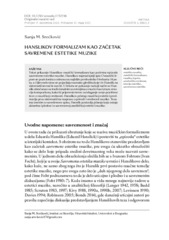Hanslikov formalizam kao začetak savremene estetike muzike
Hanslick’s Formalism as The Beginning of The Contemporary Aesthetics of Music
Чланак у часопису (Објављена верзија)
Метаподаци
Приказ свих података о документуАпстракт
Tekst prikazuje Hanslikov muzički formalizam kao početnu epizodu savremene estetike muzike. Hanslikov najznačajniji spis O muzički lepom se pozicionira u odnosu na najbliže prethodnike Herbarta i Kanta, u čijim radovima se pojavljuju naznake gledišta koje će Hanslik na sistematičan način razviti. U tekstu se pokazuje na koji način se Hanslik obračunao sa tradicionalnim uverenjima o muzici kao izrazu emocija kompozitora, kako bi pripremio teren za izlaganje svoje pozitivne teze o muzičkoj vrednosti. Hanslikov pristup muzičkoj estetici predstavlja prvu sistematičnu raspravu o prirodi i vrednosti muzike. Tezama iznetim u navedenom spisu, Hanslik postavlja pitanja koja ostaju aktuelna i plodna i u savremenoj analitičkoj estetici muzike.
The article presents Hanslick’s aesthetic formalism as the starting point of the con temporary aesthetics of music. His book, written in the 19th century, is considered
contemporary because it still proves to be influential and fruitful in the contemporary
theoretical circles, especially in the modern analytic aesthetics of music, where it is
widely cited and discussed. The article positions Hanslick’s book in relation to his
nearest predecessors Kant and Herbart, and to the neighbouring area where the for malistic view appeared, namely in Fidler’s visual formalism in fine arts. It is shown that
by being the first piece of writing to attempt to systematically and comprehensively
determine the essence and the content of music, and the criteria for evaluation of musical worth, Hanslick’s book sets the foundation for a rigorous examination of the aesthetics of music, and also breaks off with the widely ingrained preconceptions of music, which were in themselves an obstacle to ...establishing the aesthetics of music as a
scientific discipline.
Кључне речи:
estetika muzike / estetički formalizam / muzika / lepota / umetnička vrednost / istorija estetike / savremena estetikaИзвор:
Kritika: časopis za filozofiju i teoriju društva, 2021, 2, 2, 299-314Издавач:
- Beograd: Institut za filozofiju i društvenu teoriju
URI
https://kritika.instifdt.bg.ac.rs/index.php/kc/article/view/68http://rifdt.instifdt.bg.ac.rs/123456789/2472
Институција/група
IFDTTY - JOUR AU - Srećković, Sanja M. PY - 2021 UR - https://kritika.instifdt.bg.ac.rs/index.php/kc/article/view/68 UR - http://rifdt.instifdt.bg.ac.rs/123456789/2472 AB - Tekst prikazuje Hanslikov muzički formalizam kao početnu epizodu savremene estetike muzike. Hanslikov najznačajniji spis O muzički lepom se pozicionira u odnosu na najbliže prethodnike Herbarta i Kanta, u čijim radovima se pojavljuju naznake gledišta koje će Hanslik na sistematičan način razviti. U tekstu se pokazuje na koji način se Hanslik obračunao sa tradicionalnim uverenjima o muzici kao izrazu emocija kompozitora, kako bi pripremio teren za izlaganje svoje pozitivne teze o muzičkoj vrednosti. Hanslikov pristup muzičkoj estetici predstavlja prvu sistematičnu raspravu o prirodi i vrednosti muzike. Tezama iznetim u navedenom spisu, Hanslik postavlja pitanja koja ostaju aktuelna i plodna i u savremenoj analitičkoj estetici muzike. AB - The article presents Hanslick’s aesthetic formalism as the starting point of the con temporary aesthetics of music. His book, written in the 19th century, is considered contemporary because it still proves to be influential and fruitful in the contemporary theoretical circles, especially in the modern analytic aesthetics of music, where it is widely cited and discussed. The article positions Hanslick’s book in relation to his nearest predecessors Kant and Herbart, and to the neighbouring area where the for malistic view appeared, namely in Fidler’s visual formalism in fine arts. It is shown that by being the first piece of writing to attempt to systematically and comprehensively determine the essence and the content of music, and the criteria for evaluation of musical worth, Hanslick’s book sets the foundation for a rigorous examination of the aesthetics of music, and also breaks off with the widely ingrained preconceptions of music, which were in themselves an obstacle to establishing the aesthetics of music as a scientific discipline. PB - Beograd: Institut za filozofiju i društvenu teoriju T2 - Kritika: časopis za filozofiju i teoriju društva T1 - Hanslikov formalizam kao začetak savremene estetike muzike T1 - Hanslick’s Formalism as The Beginning of The Contemporary Aesthetics of Music IS - 2 VL - 2 SP - 299 EP - 314 DO - 10.5281/zenodo.5732516 ER -
@article{
author = "Srećković, Sanja M.",
year = "2021",
abstract = "Tekst prikazuje Hanslikov muzički formalizam kao početnu epizodu savremene estetike muzike. Hanslikov najznačajniji spis O muzički lepom se pozicionira u odnosu na najbliže prethodnike Herbarta i Kanta, u čijim radovima se pojavljuju naznake gledišta koje će Hanslik na sistematičan način razviti. U tekstu se pokazuje na koji način se Hanslik obračunao sa tradicionalnim uverenjima o muzici kao izrazu emocija kompozitora, kako bi pripremio teren za izlaganje svoje pozitivne teze o muzičkoj vrednosti. Hanslikov pristup muzičkoj estetici predstavlja prvu sistematičnu raspravu o prirodi i vrednosti muzike. Tezama iznetim u navedenom spisu, Hanslik postavlja pitanja koja ostaju aktuelna i plodna i u savremenoj analitičkoj estetici muzike., The article presents Hanslick’s aesthetic formalism as the starting point of the con temporary aesthetics of music. His book, written in the 19th century, is considered
contemporary because it still proves to be influential and fruitful in the contemporary
theoretical circles, especially in the modern analytic aesthetics of music, where it is
widely cited and discussed. The article positions Hanslick’s book in relation to his
nearest predecessors Kant and Herbart, and to the neighbouring area where the for malistic view appeared, namely in Fidler’s visual formalism in fine arts. It is shown that
by being the first piece of writing to attempt to systematically and comprehensively
determine the essence and the content of music, and the criteria for evaluation of musical worth, Hanslick’s book sets the foundation for a rigorous examination of the aesthetics of music, and also breaks off with the widely ingrained preconceptions of music, which were in themselves an obstacle to establishing the aesthetics of music as a
scientific discipline.",
publisher = "Beograd: Institut za filozofiju i društvenu teoriju",
journal = "Kritika: časopis za filozofiju i teoriju društva",
title = "Hanslikov formalizam kao začetak savremene estetike muzike, Hanslick’s Formalism as The Beginning of The Contemporary Aesthetics of Music",
number = "2",
volume = "2",
pages = "299-314",
doi = "10.5281/zenodo.5732516"
}
Srećković, S. M.. (2021). Hanslikov formalizam kao začetak savremene estetike muzike. in Kritika: časopis za filozofiju i teoriju društva Beograd: Institut za filozofiju i društvenu teoriju., 2(2), 299-314. https://doi.org/10.5281/zenodo.5732516
Srećković SM. Hanslikov formalizam kao začetak savremene estetike muzike. in Kritika: časopis za filozofiju i teoriju društva. 2021;2(2):299-314. doi:10.5281/zenodo.5732516 .
Srećković, Sanja M., "Hanslikov formalizam kao začetak savremene estetike muzike" in Kritika: časopis za filozofiju i teoriju društva, 2, no. 2 (2021):299-314, https://doi.org/10.5281/zenodo.5732516 . .


